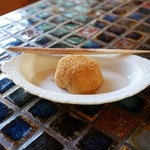
とま屋
Tomaya
3.09
Gion, Kiyomizu-dera, Higashiyama
「Japanese Sweets」
--
--
Opening hours: 13:00-17:00 Open Sundays
Rest time: Mondays (plus irregular holidays) Business hours and holidays are subject to change, so please check with the store before visiting.
京都府京都市左京区若王子町25
Photos
(20)
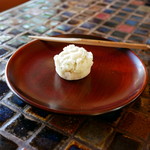

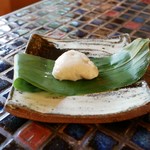
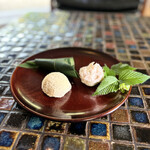
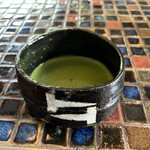
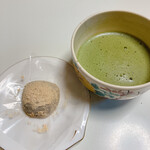
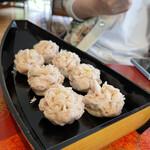
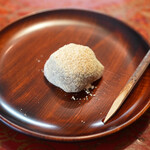
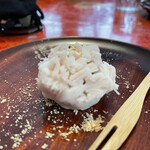
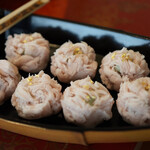
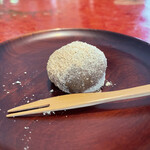
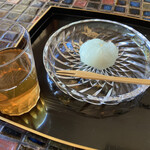
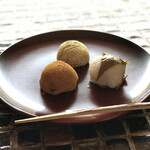
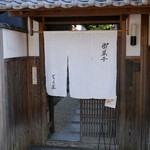
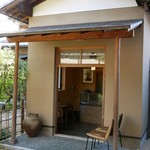
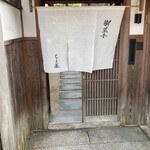
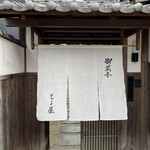
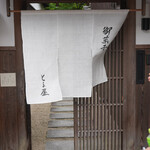
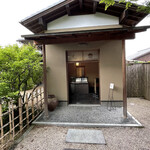
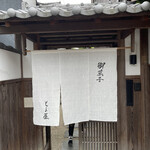
Details
Reservation Info
can be reserved
Payment Method
No credit cards
Electronic money is not accepted
Number of Seats
8 seats
(2 tables)
Private Dining Rooms
None
Smoking and Non-Smoking
No smoking at the table
Parking
None
Facilities
Calm space
Comments
(17)
gunmadontist
0.00
Resting my tired feet after a long walk at Tamaya, a shop I always rely on behind Eikando. A favorite traditional Japanese sweets shop that I visit almost every time I come to Kyoto. This time, in addition to the classic warabi mochi, I also tried the white bean paste kinton and mugwort wheat gluten bun. The smooth texture and crisp sweetness of the bean paste are exquisite. #Tamaya #EikandoGourmet #PhilosophersPathCafe



9014桜
3.80
On a nice day with good weather, I took a walk from Kikuzaki to the entrance of the Philosopher's Path near Nanzenji Temple and found a sign that said "sweets." When I went in, I found they had warabi mochi and chestnut sweets. The owner showed me around and mentioned that they also have a small eat-in area, but since there were already two groups of customers, I decided to get my order to go. The lady was very friendly and it seemed like she wasn't focused on making a profit. I enjoyed the delicious treats at home. Each piece cost 400 yen.

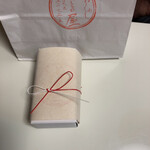

ミトミえもん
4.00
Mitomi Emon's gourmet site is now live. Homepage: "https://blog.33inc.jp/" Instagram: "@mitomi_emon" Kyoto is known for its closed-off mentality despite being a popular tourist destination. Many exclusive restaurants and hidden gems can be found throughout the city. Today, let's introduce one of these hidden spots, the traditional Japanese confectionery shop called "Tomaya." Located near the famous autumn foliage spot, Eikando Temple, this shop is housed in a renovated old mansion with a serene garden view. Each handmade confectionery by the owner, Yayo Tobi, takes time to create, but the leisurely atmosphere makes it feel like a luxurious experience. One such treat is the Warabi Mochi, which perfectly complements the relaxed ambiance. It's surprising that a shop of this quality doesn't have long lines. Tomaya truly embodies the essence of Kyoto, a hidden gem known only to a select few. Thank you for the wonderful meal.



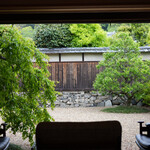
yasai572
4.10
There is very little basic information available here, so finding this place from a gourmet website is extremely difficult. Why is it so hard to find? Perhaps they are not interested in doing business. Maybe they don't want customers to come. An elderly woman runs the place by herself. It is completely different from a regular Japanese sweets shop. There is no display, and almost no pre-made items. The shop is spacious. The waiting area is very impressive, and you can relax while looking at the garden. However, because she runs the shop alone, it may take some time. It is recommended to visit with two people. If you come with a large group, the waiting time might be too long. Nonetheless, this place is definitely a hidden gem. The warabi mochi is exquisite. It is fluffy with a refined sweetness. If this were in Ginza, it would become a classic souvenir. I would like to visit again. Thank you for the meal.



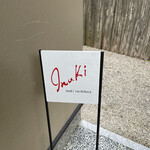
gunmadontist
0.00
A sublime chestnut sweet with a scent reminiscent of autumn, melting away like snowflakes while leaving behind a lingering aroma. The smooth texture and elegant sweetness of the chestnut paste are on par with the renowned Shougetsu. It is a uniquely beautiful and delicate Japanese confectionery with a strong and distinctive character. The Warabi mochi, known for its fluffy texture and hint of cinnamon, is also an outstanding creation. Grateful for the encounter with this awe-inspiring establishment. The shop, run by a lady on her own, is one that I would like to quietly visit for a long time. *I forgot to take a photo of the chestnut sweet.
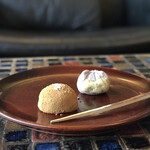
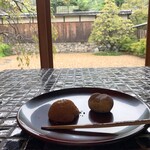
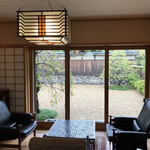

カフェモカ男
3.80
Located north of Eikan-do in Kyoto, south of the Philosopher's Path, is a charming little shop called "Tomaya." At first, it was a bit hard to find the shop as it had a modest sign with the shop's name written on a lattice door, resembling the entrance to a typical townhouse. Walking along the narrow stone path, reminiscent of an eel's sleeping place, we finally arrived at the entrance. The shop is part of a private residence, serving as a salon space where you can dine in. The view of the garden from the window was delightful. We ordered white bean and sweet potato, fu manju, and cinnamon-flavored warabi mochi. Here are our thoughts on the desserts:
- The white bean and sweet potato dessert was like a fluffy white sweet potato. It had a gentle sweetness that highlighted the quality of the ingredients.
- The fu manju had a fragrant scent of bamboo leaves and the softness of fresh fu, making it incredibly delicious. The white bean paste inside was elegantly sweet.
- The warabi mochi here uses high-quality bracken powder. We tried the cinnamon-flavored warabi mochi, which was unlike the usual warabi mochi with kinako. Instead, it had a white sweet bean paste wrapped in bracken, topped with kinako and cinnamon. It was round like a traditional manju, with a jelly-like texture. The shop is run by a mature lady who does everything herself. If the desserts are available, you can purchase them, but it's best to make a reservation to ensure availability. We left the shop feeling completely satisfied. Highly recommended.

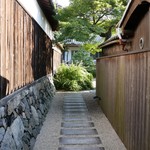
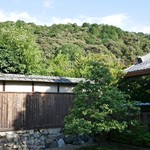

amiina
5.00
Reservation-only sales. Two types of warabi mochi and chestnut sweet potato.
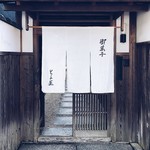
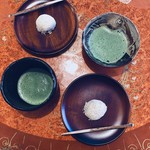
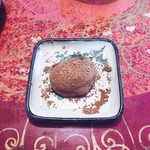
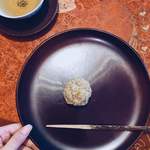
kanon199707
5.00
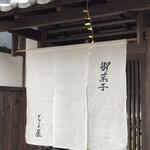
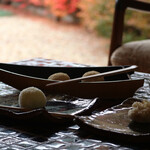
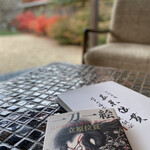
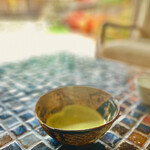
kyoto321
4.00
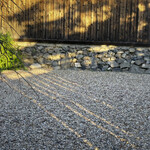
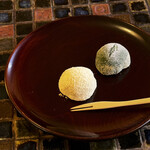
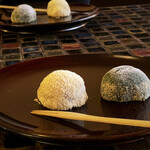

itknit
3.30

gunmadontist
0.00

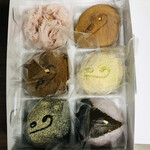
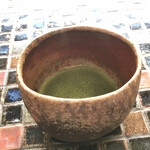
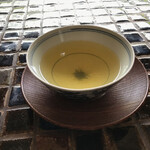
アルボス
4.10
It was the afternoon of the New Year in 2018, with the air filled with a fresh atmosphere. I headed towards this place, located just north of Eikando Temple on the southern end of the Philosopher's Path. This is a renowned traditional Japanese confectionery shop known for its warabi mochi in Kyoto. In the past, they only offered take-out, but when I passed by the shop, I noticed a sign that said "Warabi Mochi & Matcha" and decided to check it out. It turns out they had started a salon space in one of the rooms of their residence around the summer of last year (2017). To enter the salon, you need to take off your shoes at the entrance. I was lucky to be seated at a table by the window and was served a complimentary plate of Hanabira Mochi with a beautiful harmony of colors on the table. The elegant table turned out to be Danish-made, and the exquisite presentation of the Hanabira Mochi along with the breathtaking view of Higashiyama created an unforgettable memory for the New Year. The menu inside the shop includes a set of Warabi Mochi and Matcha (1300 yen) and in winter, they offer Kibi Zenzai (1300 yen). I ordered the Kibi Zenzai, which was a soup-less type with dumplings made of kibi (millet) and served with high-quality sweet bean paste. The natural flavor of the kibi and the premium sweet bean paste complemented each other perfectly, making it a delightful experience while enjoying the view through the window. The interior of the shop is a Western classical space with only two tables. Classical music from a seemingly old JBL speaker playing vinyl records creates an elegant atmosphere that feels far from everyday life. When I moved to the sales area to pay, I noticed some postcards on display and ended up buying about six of them. It turned out that they were works by the late woodblock print artist, Ikan Tachihara (1951-2015), who is the husband of the female shop owner. Their daughter runs a gallery called Arte Bincro Ikan, where they showcase his works. http://inuki-art.com I also purchased a Hanabira Mochi (400 yen) to take home, along with the Warabi Mochi (regular and cinnamon flavors) which I had enjoyed in the salon. If you're in the area, I highly recommend visiting "Tomaya" where you can enjoy Warabi Mochi and Matcha sets in the salon space, as well as Kakigori in the summer and Zenzai in the winter. The location is very close to the southern end of the Philosopher's Path near the Nansen-ji Temple and the Wakaoji Shrine. While the menu items may be on the pricier side, the traditional Japanese confections they offer have a deep charm that resonates with each visitor's taste and sensibility.
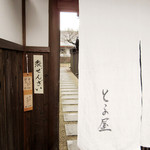

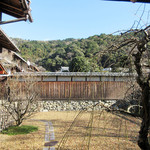
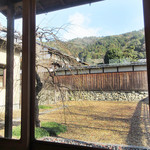
紫陽花の朝
4.00
After leaving the bread cafe, I wanted to go to another place based on reviews from other people, so I brought my niece along and we entered the shop. We passed through the curtain and went to the back of the store, then rang the bell. The elegant and cheerful lady who came out told us that the bracken rice cakes were sold out. When I asked if there was anything else, she said they had sweet bean jelly, which was a special creation this time. She let us try two pieces each, which were the actual size of the product. They were fresh and somehow elegant, as if the maker's heart was in them. They also had sweet potato jelly, so I bought two pieces of sweet bean jelly and two pieces of sweet potato jelly to take home. Personally, I found the sweet potato jelly even more delicious than the sweet bean jelly. It gently melts in your mouth with its sweetness... I will make a reservation and visit again next time. I am grateful to the shop staff and the reviewer. Thank you! (^_^)v
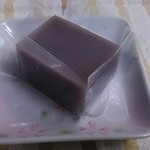
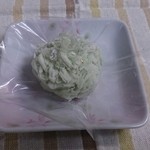
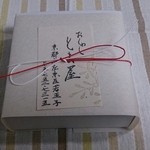

アルボス
3.90
While strolling around Nanzen-ji to Eikan-do area, I came across a traditional Japanese confectionery shop with a sign that reads "Tomaya" near the end point of the Philosopher's Path, close to Kumano Wakōji Shrine. Without the sign advertising their specialty, "Warabi Mochi (4 pieces for 1200 yen)", one might easily overlook this hidden gem. The confections I found here were not your typical Kyoto traditional sweets nor the trendy creations by young artists, but rather a sophisticated expression of skilled craftsmanship and high-quality ingredients. From the red bean-filled Warabi Mochi to other intricately designed confections, it's rare to encounter such refined sweets even in Kyoto. As I continued on, I stumbled upon a mansion with a view of Higashiyama, where an elderly lady emerged and presented three exquisite confections in a small sales space. Luckily, I was able to purchase some for takeout on that day, but typically orders are taken at the nearby Shōgetsu in Murasakino. There is no seating available, only takeout. The Warabi Mochi (filled with red bean paste) priced at 300 yen each, was made with premium Warabi flour resulting in a rich amber-colored mochi with a soft, melt-in-your-mouth texture. The delicate white bean paste inside offered a depth of flavor that was both subtly sweet and incredibly satisfying. The Kinako (sweetened soybean flour) priced at 400 yen each, was fluffy with a white bean paste center, creating a delicate and heavenly taste with a fine texture. The Doamyouji (rice cake made from glutinous rice) priced at 300 yen each, had a light green color with a white bean paste made from carefully cooked white beans. It had a hint of yuzu flavor, giving it a delicate and fleeting taste with a lingering depth. The elderly lady at the shop mentioned that she creates these simple yet elegant confections by herself, highlighting the quality of the ingredients. With decades of experience, the shop has been running for 15 years. Despite the modest prices, the confections exuded a sense of luxury and quality. While these may not be everyone's cup of tea due to their delicate nature, the subtle sweetness and richness of the ingredients resonate to create a profound depth of flavor. Among them, the red bean-filled Warabi Mochi may appeal to many. As the shop allows for spontaneous purchases if the items are available, I highly recommend giving them a try.
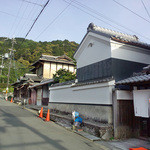
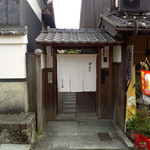

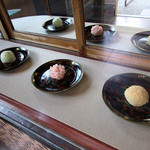
fjky
3.50
On October 22, 2019, on a Tuesday morning, my wife brought home something special that she had bought the previous afternoon. It was the most beautiful chestnut sweet I have ever seen. When I tasted it, it melted in my mouth, creating a wonderful texture. I am grateful for the existence of such chestnut sweets in the world and for being able to taste them. I would like to make a reservation and visit the store next time.
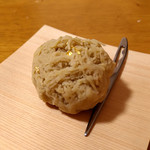
革靴を履いたカモシカ
3.50
While taking a walk, I happened to come across a traditional Japanese confectionery shop. They offered warabi mochi with bracken starch and mugwort, as well as a mochi with yuzu citrus flavor. I couldn't decide between the two, so maybe because of the time or just out of kindness, they gave me both as a service. When I tried them, the sweetness was gentle and the texture was so soft and fluffy that it seemed like it would melt in my mouth. Both were delicious. I was surprised to learn that these delicious sweets were made by an elderly lady all by herself, quietly running her business. She mentioned that she usually makes the sweets after receiving orders, so I felt grateful to have encountered these treats.
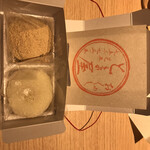
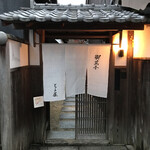
picotin
3.50
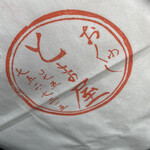
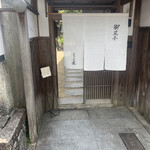

Email Login